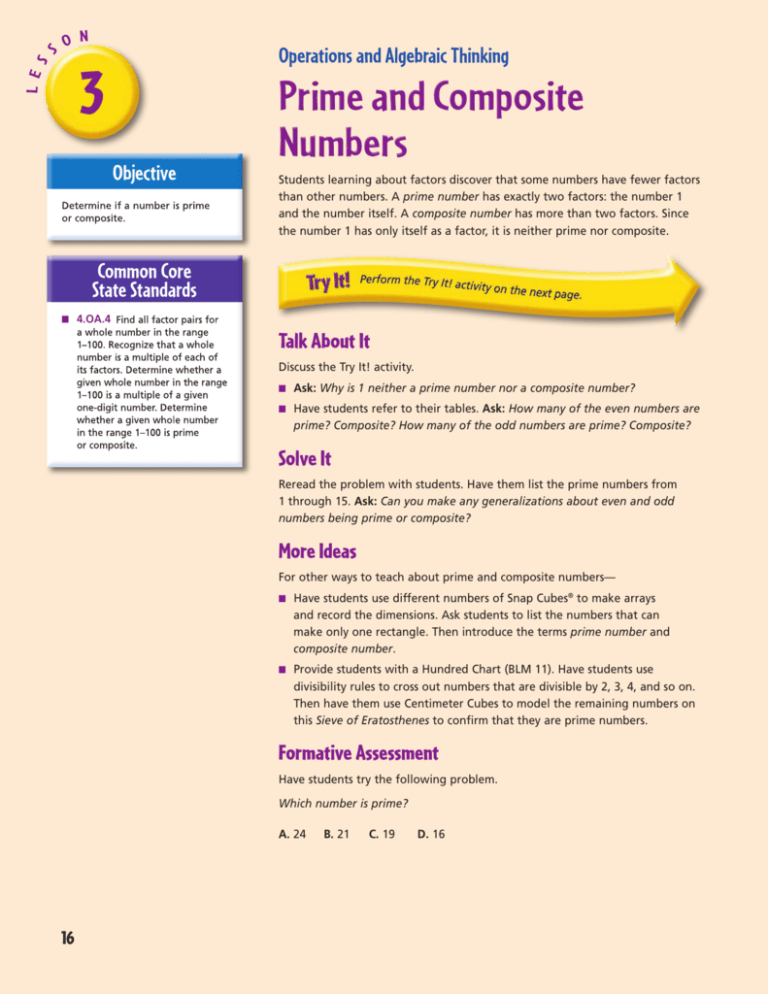Prime and Composite Numbers Prime and Composite Numbers
advertisement

Operations and Algebraic Thinking 3 Objective Prime and Composite Numbers Students learning about factors discover that some numbers have fewer factors than other numbers. A prime number has exactly two factors: the number 1 and the number itself. A composite number has more than two factors. Since the number 1 has only itself as a factor, it is neither prime nor composite. Common Core State Standards ■■ 4.OA.4 Talk About It Discuss the Try It! activity. ■■ Ask: Why is 1 neither a prime number nor a composite number? ■■ Have students refer to their tables. Ask: How many of the even numbers are prime? Composite? How many of the odd numbers are prime? Composite? Solve It Reread the problem with students. Have them list the prime numbers from 1 through 15. Ask: Can you make any generalizations about even and odd numbers being prime or composite? More Ideas For other ways to teach about prime and composite numbers— ■■ Have students use different numbers of Snap Cubes® to make arrays and record the dimensions. Ask students to list the numbers that can make only one rectangle. Then introduce the terms prime number and composite number. ■■ Provide students with a Hundred Chart (BLM 11). Have students use divisibility rules to cross out numbers that are divisible by 2, 3, 4, and so on. Then have them use Centimeter Cubes to model the remaining numbers on this Sieve of Eratosthenes to confirm that they are prime numbers. Formative Assessment Have students try the following problem. Which number is prime? A. 24 16 B. 21 C. 19 D. 16 Try It! 25 minutes | Groups of 4 Here is a problem about prime and composite numbers. Danielle wants to find all the prime numbers from 1 to 15. Can you help her? 1. Have students use tiles to build arrays for the numbers 1, 2, and 3. Have them record their data. Explain that a prime number has exactly two factors, 1 and itself. Say: The numbers 2 and 3 are prime. Ask: Is 1 prime? Explain that 1 is not prime, because it does not have two factors. It has only one factor. Materials • Color Tiles (100 per group) • Tile Arrays recording sheet (BLM 2, 1 per group) • pencils (1 per group) Operations and Algebraic Thinking Introduce the problem. Then have students do the activity to solve the problem. Distribute Color Tiles, recording sheets, and pencils to students. Review the term factors as the numbers you multiply to find a product. 2. Have students build as many arrays as they can for the numbers 4, 5, and 6. Have them record their data. Ask: Which of these numbers is prime? Elicit that 5 is prime. Explain that 4 and 6 are called composite numbers, because they have more than two factors. Discuss how the number of arrays that can be made for a number indicates whether the number is prime or composite. Students might be prone to call any odd number prime. Have them build arrays for odd numbers that are prime and for odd numbers that are composite. Remind them that 1 is neither prime nor composite. Students might not be comfortable calling 2 a prime number. Have them build the array for confirmation. 3. Have students continue building arrays and filling in the table for the numbers 7 through 15. Ask them to circle all the prime numbers in the first column of the table. 17 Lesson 3 Name Operations and Algebraic Thinking Answer Key Use Color Tiles to model each number. Write the number. Is the number prime or composite? (Check students’ work.) 1. 2 . 3 . 9; composite ________________ 8; composite ________________ 3; prime ________________ Using Color Tiles, model each number to determine if the number is prime or composite. Sketch the model. (Check students’ models.) 4 .14 5.5 6 .25 composite ________________ prime ________________ composite ________________ List all the factors of each number. 8 .30 1, 2, 4, 8, 16 __________________________ 1, 2, 3, 5, 6, 10, 15, 30 __________________________ 9.45 10. 28 1, 3, 5, 9, 15, 45 __________________________ 1, 2, 4, 7, 14, 28 __________________________ 11.27 12.39 1, 3, 9, 27 __________________________ 1, 3, 13, 39 __________________________ Hands-On Standards, Common Core Edition Download student pages at hand2mind.com/hosstudent. © ETA hand2mind™ 18 7 .16 Name Key Answer Challenge! Draw all the arrays for the number 16. How many are there? How many of them can be divided into two equal halves? Explain. How many prime numbers have an array that can be divided into two equal halves? Explain. Challenge: Check arrays; 3; 3; 16 is an even number so all its arrays can be divided into two equal halves; 2 is the only prime number whose array can be divided into two equal halves because 2 is the only even prime number. © ETA hand2mind™ Download student pages at hand2mind.com/hosstudent. Hands-On Standards, Common Core Edition 19 Lesson 3 Operations and Algebraic Thinking Name Use Color Tiles to model each number. Write the number. Is the number prime or composite? 1. 2 . 3 . ________________ ________________ ________________ Using Color Tiles, model each number to determine if the number is prime or composite. Sketch the model. 4 .14 5.5 6 .25 ________________ ________________ ________________ List all the factors of each number. 8 .30 __________________________ __________________________ 9.45 10. 28 __________________________ __________________________ 11.27 12.39 __________________________ __________________________ Hands-On Standards, Common Core Edition www.hand2mind.com © ETA hand2mind™ 18 7 .16 Name © ETA hand2mind™ www.hand2mind.com Hands-On Standards, Common Core Edition 19 BL M Name 2 Number of Arrays Dimensions Factors Tile Arrays Number of Tiles BLM 2 Tile Arrays 149 1 2 3 4 5 6 7 8 9 10 11 12 13 © ETA hand2mind™ 14 15







